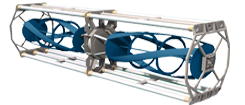What’s it mean for “solar power to provide safe water in Maoist areas?”
 The Indian government plans to install 10,000 solar power based water systems to supply safe drinking water to the people in 78 “Maoist-affected areas” (more precisely naxal-affected areas referring to various militants in parts of India). This water project is an expansion of successes in other regions of India. India’s National Rural Drinking Water Programme and the National Clean Energy Fund are funding the programs – targeting communities of ~200 people.
The Indian government plans to install 10,000 solar power based water systems to supply safe drinking water to the people in 78 “Maoist-affected areas” (more precisely naxal-affected areas referring to various militants in parts of India). This water project is an expansion of successes in other regions of India. India’s National Rural Drinking Water Programme and the National Clean Energy Fund are funding the programs – targeting communities of ~200 people.
What’s interesting is the organic technology developed to support this program. This project will use horsepower submersible pumps powered by solar panels. The water will be installed on existing high-yielding bore wells and pumped during the day into 5,000 liter storage tanks.
It is not surprising solar based water pump systems are being developed in India. There is a market with an ever growing demand. Only 35 percent of rual households in India have piped water. The goal is the dramatically increase this by 2022, which will not happen without the power to pump, purify, and pipe the water. India’ Rs +500 crore “investment” will provide larger scale validation of the reliability and maintainability of solar based water pumps systems.
India’s investment into this sort of technology is not new. As see summarized in Solar Water Purification in India, focused research and investment has been producing results. What is of great surprise is the apparent vibrant Indian solar water pump market. Just check a few of these links – all Indian – all focused on the needs of the Indian market:
- http://www.easyphotovoltech.com/solar-water-pumps.html
- http://www.aovsolar.com/solar-water-pump.html
- http://www.apex-international.org/solar-operated-hand-pump.html
- http://www.solarpowerplantsandlights.com/solar-pump.html
- http://www.newbharatgroup.com/solar-equipments.html
- http://www.kavitasolar.com/solar-water-pumps.html
- http://www.indiamart.com/pavanunit-of-revolution/solar-water-pump.html
- http://www.solarwaterpumpingsystem.com/centrifugal-solar-water-pump-627001.html
- http://vimeo.com/44037112
- http://www.environenergy.co.in/solar-plant.php
- (and many more – just search for “solar water pumps India”)
Looking through some of the solutions demonstrates intimate knowledge of the market and environment for which these systems are installed. It also indicates there is a local support foundation to repair the systems once installed.
The advise for anyone looking to “help India” with clean water needs to consult with these companies who focus on this “market.” Their market insight would prove invaluable to finding new ways to meet’s India’s 2022 goal – 90% of rural household with running tap water.
References
- Soon, 24/7 water for 10,000 naxal-hit villages in India
- Now, solar power to provide safe water in Maoist areas
- Price for rural water – Some states demand, Jairam agrees but Bengal mum
- Naxal-affected Gadchiroli district in Maharashtra has already 200 solar-water systems : Jairam Ramesh
Building a Vertical Axis Wind Turbine
Yes, you can build your own vertical axis wind turbine with this kit from http://www.windgenkits.com/
Watching the slow steady success of tidal power …

ORPC is one of many “tidal power evaluations” which are not moving to production phases. Hyundai Heavy Industries has deployed a 500 kW tidal current power system at Uldolmok Passage in Jeollanam-do, southwest Korea using the Gorlov turbine based system (similar to the ORPC system) (2). Production test phases are a core engineering milestone. It take many of the assumptions for how the mechanic and electrical systems will operation and put them under long term production stress. These lessons will be used for later production phases, continuously improving the systems.
Bottom line, tidal power will be a reality. We moving from the “hope and hype” to “engineering and experience.” With engineering and experience, we will then have the data to validate the long term economic viability of tidal power (i.e. does it make economic sense).
(1) Building good will in the community is a nice lesson learned. Some of these projects will have changes to the water line and add an “industrial” view. The open house helps.

